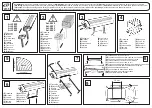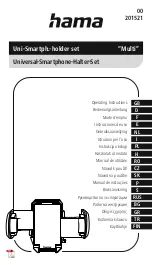
Set up the hardware
Connecting structure members
The Wireless Load Cell is designed to work with the PASCO
Structures Systems, such as the Building Better Bridges Kit
(ME-3581). The sensor can measure compression and tension
forces in any member of the PASCO Structures Systems. Use
thumbscrews to mount I-beams or other items from the
Structures Systems to the Wireless Load Cell, as shown below.
#2 Beam
#2 Beam
Thumbscrews
Figure 1. A pair of #2 I-beams being connected to the Wireless Load
Cell.
Adding Load Cells
To measure the tension and compression forces in individual
members of a PASCO Structure, replace a beam with two
shorter beams and a Wireless Load Cell, as shown below.
A Wireless Load Cell with two identical I-beams can be
substituted into the Structure as follows:
• #5 beam = Load Cell + two #3 beams
• #4 beam = Load Cell + two #2 beams
• #3 beam = Load Cell + two #1 beams
TIP: When using Wireless Load Cells, leave the
screws on the attached beams slightly loose.
This will simplify the analysis by ensuring that
the relevant members experience only tension
and compression, without moments.
The picture below shows an example of a Wireless Load Cell
connected into a PASCO Structures System.
Calibration
The Wireless Load Cell is calibrated at the factory and generally
does not need to be recalibrated. However, it is possible to
calibrate the force sensor using PASCO Capstone or SPARKvue
if needed. For instructions on calibrating the sensor, see the
PASCO Capstone or SPARKvue online help.
Direction of acceleration sensitivity
The acceleration sensing units inside the sensor are oriented so
that the lines of greatest sensitivity follow the x, y, and z arrows
indicating the direction of acceleration. Note that the software
calculates the magnitude of the resulting acceleration a
R
based
on the individual values a
x
, a
y
, and a
z
using the following
equation:
As seen in the image below, when the sensor is held with the
LOAD and FIXED sides pointing upward, the x-axis direction is
horizontal, the y-axis direction is vertical, and the z-axis direction
is perpendicular to the label on the front of the sensor.
Note that a compression force (LOAD side pushed toward
FIXED side) is measured as being positive, and a tension force
(LOAD side pulled away from FIXED side) is measured as being
negative.
Product Guide | 012-15734B
3






















